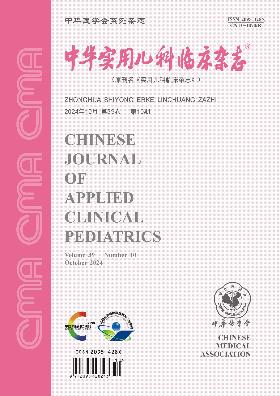儿童粘多糖病I型和心肌病病例报告及文献复习
Q4 Medicine
引用次数: 0
摘要
A case of type I mucopolysaccharide storage syndrome in children admitted to the Children's Hospital affiliated with Nanjing Medical University in January 2017 was analyzed and summarized based on the diagnosis, treatment, and prognosis of a child diagnosed with type I mucopolysaccharide storage syndrome due to cardiac enlargement. Relevant literature retrieved from the Chinese Journal Full Text Database, Wanfang Database, PubMed, and other libraries were used to analyze and summarize the diagnosis, treatment principles, and prognosis of type I mucopolysaccharide storage syndrome in children with cardiomyopathy. The child, aged 4 months and 7 days, was diagnosed with "cardiac enlargement" and had a clinical condition characterized by dense hair. After repeated respiratory infections and anti-inflammatory and cardiac strengthening treatments, the genetic results showed two heterozygous variants in the IDUA gene. They were considered to have type I mucopolysaccharide storage syndrome and cardiomyopathy. They were followed up until 11 months after birth and died due to infection after stem cell transplantation. Mucopolysaccharide storage syndrome type I is a rare disease with no specific treatment in the past. The current treatment methods include hematopoietic stem cell transplantation, enzyme replacement therapy, and gene therapy. But for mucopolysaccharide storage disease type I, early identification is more important to improve the prognosis of the disease.本文章由计算机程序翻译,如有差异,请以英文原文为准。
Case report of type I and cardiomyopathy in children with mucopolysaccharidosis and literature review
对2017年1月南京医科大学附属儿童医院收治的1例因心脏扩大就诊后检测发现黏多糖贮积症Ⅰ型患儿诊疗经过及预后情况进行整理,结合在中国期刊全文数据库、万方数据库、PubMed等图书馆检索到的相关文献,分析并总结儿童黏多糖贮积症I型并心肌病的诊治原则及预后。患儿,4个月7 d,因"心脏扩大"就诊,临床特殊有毛发浓密,反复呼吸道感染后经抗炎、强心等处理,基因结果提示IDUA基因出现2个杂合变异,考虑为黏多糖贮积症I型并心肌病,随访至出生后11个月患儿干细胞移植后因感染死亡。黏多糖贮积症I型为罕见病,既往无特异性治疗手段。目前治疗方法包括造血干细胞移植、酶替代疗法及基因治疗等。但对于黏多糖贮积症Ⅰ型更重要的是早期识别,以改善该病预后。
求助全文
通过发布文献求助,成功后即可免费获取论文全文。
去求助
来源期刊

中华实用儿科临床杂志
Medicine-Pediatrics, Perinatology and Child Health
CiteScore
0.60
自引率
0.00%
发文量
14243
期刊介绍:
Chinese Journal of Applied Clinical Pediatrics ( semi-monthly ) is a core journal of paediatrics under the supervision of China Association for Science and Technology, sponsored by Chinese Medical Association and undertaken by Xinxiang Medical College. Founded in 1986, it is openly circulated both at home and abroad. The journal has several columns, such as Expert Forum, Experimental Research and Paediatric Surgery, which are mainly for paediatric medical workers and medical researchers in hospitals. Its purpose is to reflect the new theories and technologies in paediatric medicine and scientific research at home and abroad, and to promote academic exchanges.
Chinese Journal of Applied Clinical Pediatrics is a source journal of China Science Citation Database (CSCD), a core journal of Peking University, a source journal of Chinese science and technology paper statistics (China Science and Technology Core Journals), a core academic journal of RCCSE, a high-quality scientific and technical journal of China, a high-quality scientific and technical journal of China Association for Science and Technology, and a high-quality scientific and technical journal of China Biomedical Science and Technology Association. We have been published in China Biomedical Literature Database (SinoMed), China Knowledge Network, Wanfang Data Knowledge Service Platform, China Academic Journal Abstracts, Scopus Database, Chemical Abstracts (USA), Japan Science and Technology Agency (JSTA) Database, Copernicus Abstracts (Poland), Abstracts of the Centre for Agricultural and Biological Sciences (CABS) of the United Kingdom, Cambridge Scientific Abstracts ProQuest Database, WHO Medical Journal of the Western Pacific Region (WMPR), and WHO Medical Journal of the Western Pacific Region (WMPR) of the United States. We have been included in dozens of authoritative databases at home and abroad, such as WHO Western Pacific Region Index of Medicine (WPRIM), Ullrich's Guide to Periodicals, and so on.
 求助内容:
求助内容: 应助结果提醒方式:
应助结果提醒方式:


